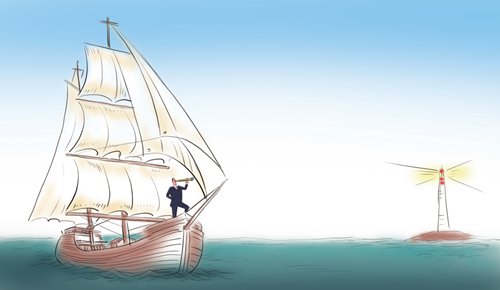Australian scholar and former official Roger Irvine's 2015 book, Forecasting China's Future: Dominance or Collapse? is one that all those who aspire to understand contemporary China and see where it is going might care to read. It gives there, in the areas of society, economy and politics, the kind of predictions made by outsiders about where China was heading in the last five decades. While the record over most of this time has been patchy, that marking the transition over the mid-1970s is the most dramatic.

Illustration: Liu Rui/Global Times
In 1977, China maintained the largely centrally-planned, state-controlled economic model it had put in place after the People's Republic of China was established in 1949. The assumption was that this would remain in place, largely unchanged. Even the Third Plenary Session of the 11th Central Committee of Communist Party of China in December 1978 was not seen by most observers at the time as an event of major significance. It was only when the first joint venture laws were passed allowing foreign capital into China from 1979 and the establishment of special economic zones like Shenzhen from 1980 that the wider world began to appreciate that things were changing.
Irvine shows that not a single Western economist foresaw what was likely to happen before it actually did over this period. That was probably because the policy-making at the time was characterized by an open-mindedness and flexibility that made unforeseen outcomes more, not less, likely.
There was no rigid template for reform. Household responsibility system and rural reforms were introduced incrementally and according to the successes and failures of local innovations. Town and village enterprises developed on the same principle. Entrepreneurs were given space to experiment. The 1980s was an era where China, economically, was like a great laboratory.
The commands over this time privileged pragmatism and empiricism, and downgraded dogmatism and a theoretical approach. "Practice must be the sole criterion for truth," went one saying from the time." "Cross the river by feeling the stones," went another. The most famous and central was "seeking truth through facts." All this implied that reality was unlikely to be captured by slavish adherence to a self-declared, all-embracing abstract model.
China's circumstances were complex - with clear differences between urban and rural economies, and between coastal, inland and western areas. These needed the most flexible framework within which to be allowed to develop. And they also needed one in which local views and knowledge could be harnessed. That was the great "liberation of thought" that 1978 involved.
This was not an easy process, and it is hard to appreciate today just how much effort went into creating a version of the "Four Modernizations" which, while it predated 1978, was able to work in ways that were not risky and ended up becoming uncontrollable. Agriculture, one of the four key areas of reform, employed huge numbers of people and accounted for over a third of China's GDP at this time. Implementing changes in ways which left people without jobs would have been disastrous. In fact, the reforms meant that with improved productivity many who worked on the land now moved into enterprise and revivified other areas of the economy. The seeds of the non-state sector, which is so important today in China, were born.
Changes in technology needed better dialogue with the outside world in order to learn from partners about processes and innovations. It also needed a transformed educational sector. Those things happened. Chinese delegations covered the world over this period, looking at science in places as far afield as Europe, Australia, America and Japan. As part of this, foreign companies started working in China. All this shows just how multi-pronged and multi-faceted the reform process was. It did not, and could, just operate in one area, but across all sectors and in all parts of society. That is why the reform process was so comprehensive in its impact.
The structure of China's economy is undergoing change once more, toward a more service sector oriented, higher consuming, more urbanized and much more high-tech driven model. This has been called the "new normal." Reform in its first decades achieved phenomenal, high speed growth - reaching double digits most of the period from 1980 to 2010. This is unprecedented for a country and economy the size of China's. This gave contemporary China the best possible material basis to move toward becoming a developed economy.
The current phase of reform is different to that which was rolled out in 1978. The Chinese economy is far more complex, and the questions of how and where to undertake reform far more complicated. But there is one thing that links the two eras, and that is a commitment to pragmatism and to being open-minded. China proved in 1978 that it was not a closed culture, but an open and embracing one. It also proved what it was like to have a creative attitude toward models and ideas in the world around it and their application to China.
In 2018, 40 years after reform, that process continues. And this time, the impact promises to be even more far reaching and dynamic than ever before.
The author is professor of Chinese studies and director of the Lau China Institute, King's College, London, and an associate of the Asia Pacific Programme at Chatham House.


